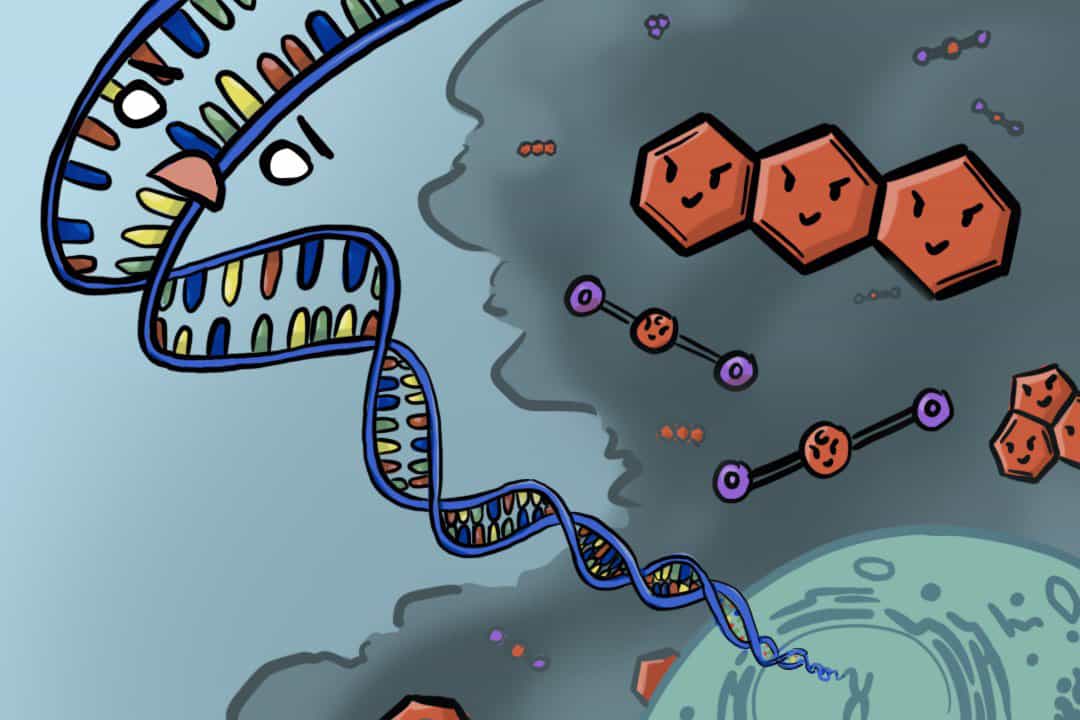Heavily condensed in the nucleus of every cell in our body is a copy of our entire genome, but each cell has a specialized function based on the set of its genes that are ‘turned on.’ Epigenetic modifications can change DNA structure, lowering gene expression and turning genes on and off as an adaptive response to the environment. The term epigenetics refers to the study of changes in our gene expression that don’t alter the DNA sequence itself.
Recent evidence suggests that environmental pollutants can alter epigenetic modification of our DNA — that chemicals might alter the expression of our genes.
What are epigenetic modifications?
Through the work of proteins called transcription factors, various genes in our DNA are expressed as different proteins with varying functions in the cell. Epigenetic modifications affect which genes can be expressed.
DNA methylation is an epigenetic modification. Methyl groups — chemical groups consisting of a carbon molecule bound to three hydrogen molecules — attach to genes to block them from being read by transcription factors — turning a gene off such that it is not expressed into a protein.
Histone modifications are another example of epigenetic change. Histones are the structural proteins that DNA wraps around to form compact, stable structures of DNA.
Adding methyl or other chemical groups to histones influences how tightly the DNA is condensed. Tightly compacted DNA can’t be read by transcription factors, preventing the expression of its genes.
How industrial pollutants influence epigenetic modifications
Industrial pollutants and toxins can alter DNA methylation patterns in animals. Also, long periods of heat stress can modify histones to make heat-tolerant genes more accessible than others. As the climate patterns change, so does the expression of specific genes in our DNA.
Consider polycyclic aromatic hydrocarbons (PAHs): a class of chemicals that result from burning coal, oil, gas, wood, garbage, tobacco, and even cooking food at high temperatures. When metabolized by the human body, PAHs can bind to DNA, causing gene damage and interfering with methylation patterns.
In San Luis Potosi, Mexico, brickmakers are exposed to high amounts of chemicals during the firing process. Particularly, these brick kilns release PAHs when the organic materials used in them as fuel combust incompletely. In 2013, researchers at the University of San Luis Potosi analyzed the levels of DNA methylation in exposed brickmakers, expecting to find abnormal levels of methylation caused by PAH exposure — and they did.
The researchers discovered that the p53 gene was hypomethylated — that is, it showed decreased epigenetic methylation. p53 is a gene coding for a tumour suppressor protein, which triggers programmed cell death, preventing damaged cells from forming cancerous tumours.
The hypomethylation of p53 indicates early events in cancer development, like chromosomal instability and breaks across both strands of DNA. A 2013 study reports hypomethylation of this gene in smoking lung cancer patients. This particular epigenetic pattern was also observed in a study conducted at the University of Padova in Italy as a consequence of the PAH exposure faced by Polish coke-oven workers, who work with fuel in industrial settings.
The researchers soon realized, however, that the epigenetic changes they saw in San Luis Potosi weren’t exclusive to brickmakers. Mexican and Peruvian women using firewood combustion and biomass stoves — stoves that burn biomass fuel for heat — to cook food displayed comparably high levels of PAH-induced epigenetic modifications.
Pollutants influence changes implicated in chronic disease
In 2023, the European Molecular Biology Organization conducted a review on the harmful effects of PAHs. Some scientists think PAHs affect methylation patterns in genes involved in the immune system — such as genes encoding cytokines.
Cytokines are small proteins that play an important role in signaling inflammation so that immune cells can respond to damaged and infected tissues. Environmentally-induced epigenetic modifications can upregulate cytokine activity, activating white blood cells, which mount a defensive immune response. Immune activation is an important response to allergens and environmental pollutants, but overactivation could lead to an autoimmune condition, where the immune system begins attacking itself chronically. Epigenetic alterations, influenced by environmental exposure to these pollutants, can underlie chronic disease pathogenesis.
To add fuel to the fire, these epigenetic modifications could be hereditary. If the DNA methylation patterns are modified in the sperm or the egg, successive generations could be born predisposed to autoimmune conditions and worsened cardiovascular health.
And PAHs aren’t the only culprits under investigation. Wildfire pollutants have increased with human-induced climate change. Pollutant exposure has been correlated with a vast range of conditions. A review by McGill University found that exposure to these pollutants can induce epigenetic changes that are implicated in asthma and chronic obstructive pulmonary disease.
Emerging research, however, offers a silver lining. Since epigenetic modifications don’t impact the DNA sequence itself, drug therapies could reverse the patterns induced by pollutants. Understanding how to interpret and regulate our genomes’ regulation system could be the key to mitigating the lasting impact of pollutants on human health.


